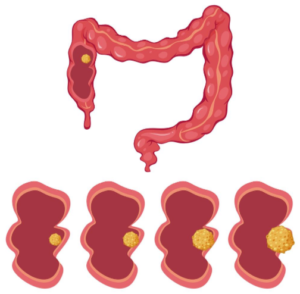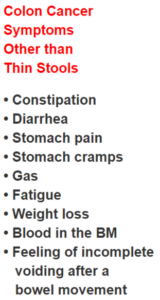If your thin or narrow stools have you fearing colon cancer, there are other causes of narrow thin stools besides cancer of the colon.
A number of factors can determine bowel movement caliber (shape, texture, color, etc.), says Whitney Jones, MD, a national expert and frequent speaker on early-age onset colon cancer prevention, and Founder, Colon Cancer Prevention Project.
Dr. Jones explains, “Stool content (e.g., solids vs. liquids), the amount of time stool spends in the gastrointestinal tract (i.e., transit/motility), and the function of the anal sphincter are all known to be involved in this process.
“Alterations in stool consistency and a resultant ‘change in bowel habits’ are known symptoms of a number of disease processes such as inflammatory bowel disease, cancer, and irritable bowel syndrome.”
And the possible causes of narrow or thin stools don’t stop there.
Have you increased your fiber intake lately?
This can cause BMs to come out thinner than usual.
Have you been eating Olestra or anything with sorbitol?
Dr. Jones says, “Ultimately, any process that affects stool consistency (e.g. dietary changes,), bowel transit or motility (e.g. chronic constipation, medicines, inflammatory conditions involving the GI tract), and/or anal sphincter function (e.g., rectal cancers, trauma, and surgeries) could result in long narrow stools.”
Your BMs may even be on the narrow side on a normal basis, and you’ve only noticed recently because perhaps you read an article on colon cancer.

Schematic of colon cancer. Source: vecteezy.com
Dr. Jones stresses that what’s particularly important is whether or not narrow, thin stools are outside the norm for your typical BM appearance.
Don’t delay discussing any change in bowel habits with a gastroenterologist.
Though narrow, thin stools can result from colon cancer, this does not mean that if you have skinny BMs, you probably have colon cancer.
It’s actually most likely from a condition other than colon cancer. This includes diverticulitis.
In fact, it might even be from microscopic colitis, which I’ve had.
One day a very long BM came out and it was on the narrow side, more narrow than usual, but not what I’d consider as thin as or like a pencil.
What made the stool appear more narrow than usual, however, was perhaps its very long length.
I imagined it being segmented, and realized that if broken into thirds or fourths, it wouldn’t seem as “narrow.”
It just so happened that this particular BM didn’t break up upon hitting the water.
Dr. Jones explains, “Regarding the caliber of stool and its correlation with the presence of left sided colon cancer, the data currently available does not necessarily indicate that narrow stools should alert patients or physicians of a possible malignant process.
“The notion that left sided colon cancer or rectal cancer often presents with narrow stools is based upon the anecdotal opinion of expert physicians of the late 19th/early 20th century.”
Dr. Jones adds: “There are no prospective studies and only a few retrospective studies in the literature that indicate that long narrow stools are correlated with cancer.
“This conception has been propagated throughout the medical literature mostly based on tradition.”

Most early colon cancer presents with no symptoms.
This is why there’s the extreme importance of getting screened for this killer with a colonoscopy.
This should begin at age 45 for people at average risk (due to age) for the disease, and then done every 10 years, unless otherwise indicated by the physician.
Anal cancer, which is rare, can also cause “narrowing of the stools,” according to the American Society of Colon and Rectal Surgeons.


 Dr. Jones’
Dr. Jones’











